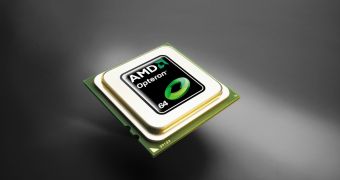After the widely shouted launch of Intel's six-core server processor Xeon 7400, Advanced Micro Devices was somehow expected to come with an answer. The new Dunnington chip, which aims at the four-socket and larger systems, doesn't look like a realistic solution for AMD when it comes to server area. What the Sunnyvale company has to say is that its 'Barcelona' Opteron CPU is able to stand at the same level with the Dunnington Xeon.
AMD plans to focus on heat to sell Barcelona against Dunnington. Dunnington's predecessor, the 'Tigerton' quad-core Xeon MP, came with an 80 watt thermal design point (TDP). The new 45nm chip, which was supposed to be cooler, has an actual TDP of 90 watt due to the extra cache and two more cores. On the other hand, the top-end six-core Dunnington chip, running at 2.66 GHz, has a 130-watt TDP, the same as the fastest Tigerton.
According to AMD, there is still another catch. The Dunnington servers use Fully Buffered DIMMs, which eat up to 10 or 11 watts per memory stick, while the DDR2 main memory which is used with Opterons only consumes 4 to 5 watts per stick of the same capacity. The heat produced here adds up inside larger boxes.
The Dunnington features a 1.07GHz FSB, and Intel used the 45nm process to compensate this by putting 16MB of L3 cache on the chip. Courtesy of this large cache size, and to the three 2MB L2 caches shared by core pairs on the chip, the I/O bottlenecks are easily masked, yet it is not enough to impress John Fruehe, manager of worldwide market development for AMD and a former Compaq and Hewlett-Packard marketeer.
“Intel added 50 percent more cores and got what looks like a 31 per cent more performance on virtualization,” he says. According to the Santa Clara chip manufacturer, tests unveiled as much as a 50 percent performance boost for databases, while around 35 percent more work being done on the average workload, even better than the virtualization benchmarking tests.
Fruehe also says that, when making an analysis of the x86 and x64 server sales, quarter to quarter and year to year is made, anyone can see that single-core boxes account for about 20 percent of the shipments, about 70 percent goes to the two-socket boxes area, and around 10 percent represents four-socket system shipments. This means that the eight-socket or larger x64 machines only have a tiny slice to account for.
The bigger boxes are able to provide larger profits, and vendors have this in mind when working on them, yet this segment of the market needs a lot of consolidation. The non-x64 lines are still highly profitable to some Intel or AMD partners. According to Fruehe, things may change in server distribution, although it is not the case in the past ten years. The combination of virtualization and server consolidation is able to make customers turn to bigger boxes. The virtualization is spreading around on all platforms as a fact. Revenues dropped in the past decade due to the new adoption and the consolidation of footprints.
Both AMD and Intel will launch new server processors in the near future
AMD still considers the four-socket segment a good one. “While the eight-way server is not a volume market, and it is not growing dramatically, the four-socket server is still a real stronghold for us,” says Fruehe. According to him, the HyperTransport interconnect, along with the integrated memory controllers of the Opteron architecture, offers AMD a good advantage on the performance side, clock for clock and core for core, when put beside a Xeon.
The problem with Intel's processors is that their front side bus architecture doesn't scale well enough, which matters a lot in bigger systems. Intel already announced that its future “Nehalem” Xeons and “Tukwila” Itaniums would feature the QuickPath Interconnect, a technology similar to the Opteron interconnect, along with on-chip memory controllers.
“The majority of the world looks at the top bin parts and tells vendors that these are great for benchmarks, but these are not the chips that most people buy,” explains Fruehe. These parts are a lot hotter, although they boost more speed. AMD and Intel will actually compete for most sales on the standard parts segment.
AMD hasn't managed to get big systems on its x64 chips, as Intel did. There are 16-socket Xeon boxes from IBM, NEC, and Unisys that could use Tigerton and now Dunnington chips, while the biggest Opteron boxes are the eight-socket DL785 from Hewlett-Packard and X4600 from Sun Microsystems. Eight-way machines and boards are also sold by motherboard makers Tyan and Super Micro.
Today's Barcelona Opterons run at 2.3GHz and need to face the Dunningtons at the high-end and the Harpertown Xeons in the two-socket area. According to Fruehe, this situation will also change, as the "Shanghai" 45 nanometer shrink of the Barcelona chips is to come in two-socket (2000 series) and four-socket and larger (8000 series) servers during the fourth quarter of 2008.
AMD's partners will probably have systems deployed by the end of the year, and the Sunnyvale company will ship the Shanghai chips for revenue. The processors will feature 6MB of L3 cache (three times more than the Barcelonas) and higher clock speeds. They will also come with some tweaks in the instruction stream which will enable them to deliver somewhere between 15 and 30 percent more performance.

 14 DAY TRIAL //
14 DAY TRIAL //